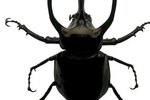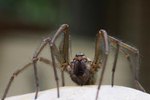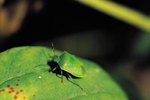
Collectively, four species of carpet beetles are more important economically than clothes moths, responsible for losses to fabrics in the process of manufacture and storage, and countless small damages in households across North America. Voracious scavengers, their larvae travel throughout homes, factories, warehouses and museums foraging for food, destroying fabrics, rugs, upholstery and animal products in their path.
Innocuous Adult Carpet Beetles
Named for their larval predilection for wool carpets, carpet beetles have a complete metamorphosis four distinct life stages; embryo or egg, larva, pupa and imago or adult. Members of the family Dermestidae, carpet beetles are in the order Coleoptera. Frequently seen on flowers around homes and other buildings, adults feed upon the nectar and pollen of a variety of plants. They enter buildings in the spring and early summer. Small and unobtrusive, they are rarely noticed inside, favoring dark, quiet corners where they deposit their eggs, then die shortly after. They do not do any damage inside.
Black Carpet Beetle
Black carpet beetles (Attagenus megatoma) are the most widespread and abundant of the carpet beetles and cause the greatest damage. The shiny black adults are an elongated oval-shaped with brownish legs, and they grow to 1/4 inch long. Within five days of emerging from their pupa, females deposit about 50 eggs over a three-week period in lint, air ducts and under baseboards.
Hatching within 11 days, the diminutive, cigar-shaped larvae have a long brush of tail bristles and are light brown to black. Over a series of five to 11 molts, they grow to almost 1/2 inch long, pupate for up to 24 days, then emerge as adults. Larvae avoid light and are often found in closets, edges of carpets or rolled up in woolen materials. They feed primarily on dead animal materials, hair, fur, hides, horns and wool and silk garments in which they make large, irregular holes. They also infest cereals, stored grain and nuts.
Varied Carpet Beetle
Varied carpet beetles (Anthrenus verbasci) are round and much smaller than black carpet beetles, with a white, brown and yellow variegated pattern on their backs. Larvae hatch in 17 to 18 days, and over a period of seven to 11 months they molt seven to eight times. The broad larvae grow up to 1/4 inch long and have three pairs of turfs at the end of their abdomens. Outside, larvae are common in bird and spider nests. Inside, they feed on items such as wool, carpets, hides, feathers, horns, bone, insect pupae, insect collections, rye meal, corn and red pepper.
Common Carpet Beetle
Common carpet beetles are distinguished by a varied pattern of white and orange scales on their gray to black backs with an orange-red band of scales down the middle. The small, round females deposit 30 to 40 miniscule, white eggs that hatch in 10 to 20 days. Reddish-brown, the elongated oval-shaped larvae are covered in bristly black or brown hairs and grow to ¼ inch long, averaging six molts over 60 to 70 days. They feed on items such as wool, furs, feathers and silk; a common problem in museums, they feed on dead animal specimens and insect collections.
Furniture Carpet Beetle
Named for their habit of attacking upholstered furniture, furniture carpet beetles (Anthrenus flavipes) are little, round beetles with a mottling of yellow and white scales on their black backs, and a heavy coating of yellow scales on the top of their legs. Females lay up to 100 eggs that hatch in about three weeks. Larvae are elongated oval-shaped and covered in bristly brown hairs, molting six to 12 times over six months. Frequently found crawling on furniture, larvae feed on items such as hair, padding, feathers, wool, carpets, fur, bristles, horns, silk, linen, cotton, rayon and jute.
References
- Pest Control Canada: Carpet Beetles
- Orkin Pest Control: Black Carpet Beetle
- Orkin Pest Control: Carpet Beetle Larvae
- Orkin Pest Control: Carpet Beetle Life Cycle
- Orkin Pest Control: Carpet Beetle Damage
- Orkin Pest Control: Carpet Beetles Around the House
- Colorado State University Extension: Carpet Beetles
- Scientific Guide to Pest Control Operations, Purdue University; Lee C. Truman, Ph.D., et al.
Photo Credits
-
Stewart Sutton/Digital Vision/Getty Images
Writer Bio
Based in Ontario, Susan Dorling has written professionally since 2000, with hundreds of articles published in a variety of popular online venues. Writing on a diverse range of topics, she reflects her passion for business, interior design, home decorating, style, fashion and pets.




